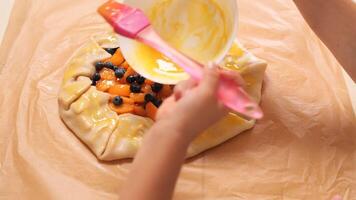Egg Wash Recipe: Egg wash is a simple yet indispensable mixture used in cooking and baking to give dishes a professional finish. Made primarily from eggs, this mixture is brushed onto pastries, breads, and even some savory dishes to enhance their appearance. Its ability to impart a golden-brown sheen and bind ingredients makes it a favorite among chefs and home cooks alike. Whether you’re baking a flaky pie crust or sealing the edges of empanadas, egg wash is your go-to tool for adding that final touch.
Ingredients for Egg Wash
To prepare an egg wash, you only need a few basic ingredients. Here’s what you’ll need:
Basic Ingredients:
- 1 large egg.
- 1 tablespoon of liquid (water, milk, or cream).
Optional Add-ons:
- A pinch of salt for a savory touch.
- A sprinkle of sugar for a sweet glaze.
- Food coloring for decorative purposes.
These additions allow you to customize the egg wash based on your recipe’s requirements.
Types of Egg Wash
Egg wash comes in several variations, each serving a unique purpose:
- Whole Egg Wash: Combines the yolk and white for a balanced sheen and color.
- Egg Yolk Wash: Offers a rich, golden finish, perfect for pastries and pies.
- Egg White Wash: Provides a glossy, light-colored glaze ideal for bread.
- Milk or Cream Wash: Adds a matte finish and subtle flavor, commonly used on scones and biscuits.
Understanding the differences helps you achieve the perfect finish for your dish.
Choosing the Right Egg Wash for Your Recipe
The type of egg wash you choose depends on your desired result:
- Golden Finish: Use egg yolk for a deep, rich color.
- Glossy Appearance: A whole egg wash works best.
- Neutral Shine: Opt for egg white for a subtle touch.
- Matte Look: Milk or cream wash gives a soft, rustic feel.
For instance, a buttery croissant benefits from an egg yolk wash, while breadsticks might shine with a whole egg wash.
Equipment Needed for Making Egg Wash
Before preparing your egg wash, gather these tools:
- A small bowl or ramekin for mixing.
- A fork or whisk to blend the ingredients.
- A pastry brush for application.
- Paper towels for cleanup.
Using the right equipment ensures smooth preparation and easy application.
How to Make a Basic Egg Wash
Follow these simple steps to prepare a basic egg wash:
- Crack the Egg: Break one large egg into a small bowl.
- Add Liquid: Mix in one tablespoon of water, milk, or cream.
- Whisk Thoroughly: Beat the mixture with a fork or whisk until fully combined.
- Strain if Needed: For a smoother consistency, strain the mixture to remove any lumps.
- Ready to Use: Your egg wash is now ready for application.
Avoid common mistakes like over-whisking, which can incorporate too much air, or under-mixing, which leaves streaks.
Advanced Egg Wash Recipes
While a basic egg wash works wonders, you can elevate your dishes with advanced recipes tailored to specific needs:
Sweet Egg Wash:
- Ingredients: 1 egg yolk, 1 tablespoon of heavy cream, 1 teaspoon of sugar.
- Use: Perfect for pastries like danishes, cinnamon rolls, and sweet pies.
- Result: A glossy, caramelized finish that enhances sweetness.
Savory Egg Wash:
- Ingredients: 1 whole egg, 1 tablespoon of milk, a pinch of salt.
- Use: Ideal for meat pies, empanadas, or stuffed bread.
- Result: Adds a golden crust with a hint of savory flavor.
Experimenting with these variations allows you to customize your egg wash to match the flavor profile of your dish.
Tips for Applying Egg Wash
To get a flawless finish, follow these expert tips for applying egg wash:
- Use the Right Tool: A pastry brush ensures even coverage, but a silicone brush works well for larger areas.
- Brush Gently: Avoid pressing too hard to prevent damaging delicate doughs.
- Apply Evenly: Use a light hand to avoid pooling, which can lead to uneven browning.
- Timing Matters: Brush the egg wash on right before baking to maintain its consistency and effect.
For an even coating, rotate your dish while applying the egg wash, ensuring every angle is covered.
Egg Wash Alternatives
Not everyone can use traditional egg wash due to dietary restrictions. Here are some excellent substitutes:
Dairy-Free Options:
- Olive oil or coconut oil brushed on top provides a natural sheen.
- Almond milk or soy milk can mimic the matte finish of a milk wash.
Vegan Alternatives:
- A mixture of aquafaba (chickpea water) and a pinch of sugar works as a great egg substitute.
- Flaxseed gel or cornstarch slurry creates a subtle glaze.
These alternatives allow those with allergies or specific diets to achieve similar results without compromising on quality.
Common Uses of Egg Wash
Egg wash is a versatile tool in the kitchen. Here are some of its most common applications:
Baking:
- Gives pies, bread, and pastries a golden-brown, glossy appearance.
- Seals edges of pies and dumplings to prevent leakage.
Cooking:
- Adds a crispy, appetizing coating to roasted meats.
- Helps breadcrumbs stick when preparing fried dishes like chicken or fish.
Using egg wash creatively can transform ordinary recipes into visually appealing masterpieces.
Benefits of Using Egg Wash
Why should you bother with egg wash? Here’s why:
- Enhances Appearance: A glossy, golden crust makes your dishes look professionally baked.
- Acts as a Binder: Holds toppings like seeds or sugar in place.
- Seals Edges: Prevents fillings from spilling out during cooking.
- Improves Texture: Creates a crispy exterior on baked and roasted items.
An egg wash is a small step with big rewards, elevating the overall quality of your dish.
Troubleshooting Egg Wash Problems
Sometimes, egg wash application doesn’t go as planned. Here’s how to fix common issues:
Uneven Color:
- Cause: Inconsistent application.
- Solution: Apply a second light coat for uniformity.
Streaky Finish:
- Cause: Under-mixed egg wash.
- Solution: Whisk thoroughly before application.
Pooling:
- Cause: Excess egg wash left on the surface.
- Solution: Dab with a paper towel to remove excess before baking.
Addressing these issues ensures your dishes come out picture-perfect every time.
Egg Wash Safety Tips
Since egg wash involves raw eggs, it’s essential to handle it safely:
- Wash Hands: Always clean your hands after handling raw eggs to prevent contamination.
- Store Properly: If you have leftover egg wash, store it in an airtight container in the fridge for up to 24 hours.
- Avoid Cross-Contamination: Use a clean brush and avoid reusing egg wash from previous applications.
Practicing good hygiene ensures your dishes are safe and delicious.
Creative Recipes Using Egg Wash
Here are some dishes where egg wash plays a starring role:
- Flaky Pie Crusts: Egg wash adds a glossy, professional finish to both sweet and savory pies.
- Golden-Brown Pastries: Whether it’s croissants or puff pastry, egg wash enhances the visual appeal and taste.
- Seeded Bread Rolls: Use egg wash as a binder for sesame, poppy, or sunflower seeds.
- Stuffed Empanadas: Seal the edges with egg wash to prevent leaks and create a crispy, golden crust.
These recipes highlight the transformative power of a simple egg wash.
FAQs about Egg Bite Recipe
1. What are egg bites?
Egg bites are small, fluffy, and often cheesy egg-based treats that are typically cooked in a muffin tin or silicone molds. They are a popular choice for a protein-packed breakfast or snack.
2. How do you make egg bites?
To make egg bites, whisk together eggs, your choice of cheese, and any desired mix-ins such as cooked bacon, spinach, or bell peppers. Pour the mixture into greased muffin tins or silicone molds and bake in a preheated oven at 350°F (177°C) for about 20-25 minutes or until set.
3. Can egg bites be made in advance?
Yes, egg bites are perfect for meal prep. They can be made in advance and refrigerated for up to a week or frozen for up to a month. Reheat them in the microwave for a quick and easy breakfast.
4. Are egg bites healthy?
Egg bites are a healthy option as they are high in protein and can be loaded with vegetables. Choosing low-fat cheese and lean meats can make them even healthier.
5. Can you customize egg bite flavors?
Absolutely! Egg bites are highly customizable. You can add different cheeses, vegetables, and proteins according to your taste preferences and dietary needs.
6. How do you prevent egg bites from sticking to the pan?
To prevent sticking, thoroughly grease your muffin tins or silicone molds with cooking spray or oil. Silicone molds are especially recommended for easy removal and cleanup.
7. What is the best way to store egg bites?
Store egg bites in an airtight container in the refrigerator. For longer storage, wrap each egg bite individually in plastic wrap and place them in a freezer-safe bag before freezing.
8. Can egg bites be eaten cold?
While egg bites are usually served warm, they are also delicious cold, making them a convenient on-the-go snack.
Conclusion
Egg wash is a small yet impactful addition to any kitchen. Its versatility, simplicity, and ability to elevate dishes make it an essential skill for cooks of all levels. From creating golden-brown pastries to sealing stuffed delicacies, mastering the art of egg wash unlocks countless culinary possibilities. So, grab your whisk, and start experimenting to see the magic for yourself!



